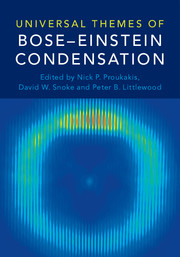Book contents
- Frontmatter
- Contents
- Foreword
- Preface
- Part I Introduction
- Part II General Topics
- Editorial Notes
- 5 The Question of Spontaneous Symmetry Breaking in Condensates
- 6 Effects of Interactions on Bose-Einstein Condensation
- 7 Formation of Bose-Einstein Condensates
- 8 Quenches, Relaxation, and Prethermalization in an Isolated Quantum System
- 9 Ultracold Gases with Intrinsic Scale Invariance
- 10 Berezinskii-Kosterlitz-Thouless Phase of a Driven-Dissipative Condensate
- 11 Superfluidity and Phase Correlations of Driven Dissipative Condensates
- 12 BEC to BCS Crossover from Superconductors to Polaritons
- Part III Condensates in Atomic Physics
- Part IV Condensates in Condensed Matter Physics
- Part V Condensates in Astrophysics and Cosmology
- Universal Bose-Einstein Condensation Workshop
- Contributors
- Index
- References
5 - The Question of Spontaneous Symmetry Breaking in Condensates
from Part II - General Topics
Published online by Cambridge University Press: 18 May 2017
- Frontmatter
- Contents
- Foreword
- Preface
- Part I Introduction
- Part II General Topics
- Editorial Notes
- 5 The Question of Spontaneous Symmetry Breaking in Condensates
- 6 Effects of Interactions on Bose-Einstein Condensation
- 7 Formation of Bose-Einstein Condensates
- 8 Quenches, Relaxation, and Prethermalization in an Isolated Quantum System
- 9 Ultracold Gases with Intrinsic Scale Invariance
- 10 Berezinskii-Kosterlitz-Thouless Phase of a Driven-Dissipative Condensate
- 11 Superfluidity and Phase Correlations of Driven Dissipative Condensates
- 12 BEC to BCS Crossover from Superconductors to Polaritons
- Part III Condensates in Atomic Physics
- Part IV Condensates in Condensed Matter Physics
- Part V Condensates in Astrophysics and Cosmology
- Universal Bose-Einstein Condensation Workshop
- Contributors
- Index
- References
Summary
The question of whether Bose-Einstein condensation involves spontaneous symmetry breaking is surprisingly controversial. We review the theory of spontaneous symmetry breaking in ferromagnets, compare it with the theory of symmetry breaking in condensates, and discuss the different viewpoints on the correspondence to experiments. These viewpoints include alternative perspectives in which we can treat condensates with fixed particle numbers, and where coherence arises from measurements. This question relates to whether condensates of quasiparticles such as polaritons can be viewed as “real” condensates.
Introduction
Spontaneous symmetry breaking is a deep subject in physics with long historical roots. At the most basic level, it arises in the field of cosmology. Physicists have long had an aesthetic principle that leads us to expect symmetry in the all of the basic equations of physical law. Yet the universe is manifestly full of asymmetries. How does a symmetric system acquire asymmetry merely by evolving in time? Starting in the 1950s, cosmologists began to borrow the ideas of spontaneous symmetry breaking from condensed matter physics, which were originally developed to explain spontaneous magnetization in ferromagnetic systems.
Spontaneous coherence in all its forms (e.g., Bose-Einstein condensation [BEC], superconductivity, and lasing) can be viewed as another type of symmetry breaking. The Hamiltonian of the system is symmetric, yet under some conditions, the energy of the system can be reduced by putting the system into a state with asymmetry, namely, a state with a common phase for a macroscopic number of particles. The symmetry of the system implies that it does not matter what the exact choice of that phase is, as long as it is the same for all the particles.
It is not obvious, however, whether the symmetry breaking which occurs in spontaneous coherence of the type seen in lasers or in Bose-Einstein condensation is the same as that seen in ferromagnetic systems. There are similarities in the systems which encourage the same view of all types of symmetry breaking, but there are also differences. In fact, there is a substantial school of thought that symmetry breaking in Bose-Einstein condensates with ultracold atoms is a “convenient fiction” (a term applied to optical coherence by Mølmer [1]).
- Type
- Chapter
- Information
- Universal Themes of Bose-Einstein Condensation , pp. 79 - 98Publisher: Cambridge University PressPrint publication year: 2017

